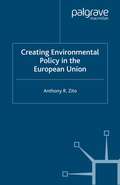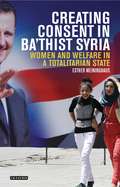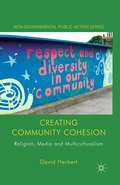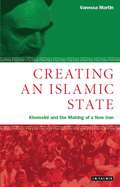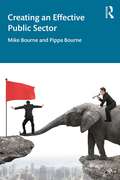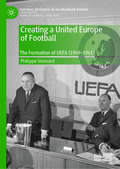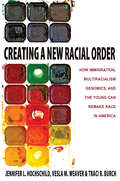- Table View
- List View
Creating Enviromental Policy in the European Union
by A. ZitoInvestigates the EU policy-making process and why this process has taken major steps to advance environmental regulation in some areas and not others. The book develops a framework emphasizing decision-making modes, which provide a more nuanced understanding, compared to traditional EU theoretical approaches, of how EU actors make decisions.
Creating Economic Stability Amid Global Uncertainty: Post-Pandemic Recovery in Mexico’s Emerging Economy
by Enrique Murillo Paolo Riccardo Morganti Javier Moreno EspinosaCOVID-19 impacted economic activity in a way that hurt households, businesses, industries, and governments. What followed immediately was a period of high uncertainty, and what’s to come is still unknown. Economists have a lot to learn from this point in history, as different countries have handled this very differently from others. This book journeys through what one emerging economy has done to attempt recovery following immense disruption: Mexico's recovery following the pandemic. This volume offers empirical studies that trace the post-pandemic recovery period in Mexico, providing insight into what this emergent economy went through and did after 2021. The first part of the book examines macroeconomics, such as tax collection, and microeconomics, such as household income. These chapters draw on policy and the actions driving the economic recover in this emergent economy. The second half of the book focuses on what organizations can do to improve internal governance as well as market success.Full of new conceptual and empirical studies, the book explains what it looks like to rebuild an emerging economy. It will appeal to economists, economic scholars, and policymakers trying to make sense of the best ways to move forward following intense period of economic instability.
Creating Economic Growth: Lessons for Europe (Palgrave Advances in Regional and Urban Economics)
by M. MagnaniAs national leaders struggle to revive their economies, the people of Europe face a stark reality, which has created an opportunity for local leaders and citizen movers and shakers to rise to the occasion to spur revitalization from the bottom up. The author offers a six-point plan to prosperity.
Creating Culturally Competent Teachers in Higher Education: As a Consequence of Cultural Immersion (SpringerBriefs in Education)
by Pavan John Antony Fayth Vaughn-ShavuoThis book presents evidence of a longitudinal study in teacher preparation utilizing a threefold multicultural (TFM) model of immersion. It establishes the need for culturally responsive teachers in classrooms, and outlines a proven model that can be employed to prepare them.Through the TFM model elements, pre-service teacher candidates participated in class-based, cohort fieldwork experience, and reflective journal writings and discussions. Evidence was gathered from pre- and post-questionnaires, interviews, classroom discussions, and journal writings, along with the inclusion of student voices. Pre-service teacher attitudes, beliefs, and degree of cultural responsiveness changed post-study, and candidates became more effective in the classroom, highlighting the effectiveness of the TFM model.This book is an invaluable resource for universities, under- and postgraduate students, and teachers across the globe as it provides a teacher preparation fieldwork model that helps to prepare culturally responsive teachers for children in any classroom.
Creating Consent in Ba‘thist Syria: Women and Welfare in a Totalitarian State (Library of Modern Middle East Studies)
by Esther MeininghausThe challenge of maintaining dictatorial regimes through control, co-optation andcoercion while upholding a façade of legitimacy is something that has concernedleaders throughout the Middle East and beyond. Nowhere is this more evidentthan in the Syria ruled by the Asads, both Hafiz and his son Bashar. Drawing onthe example of the General Union of Syrian Women (founded in 1967), EstherMeininghaus offers new insights into how the Syrian Ba?thist regimes attemptedto move beyond mere satisfaction with the compliance of the citizenry and toconsolidate their rule amongst the local population. Meininghaus argues that thiswas partially achieved through providing welfare services delivered by the Union asone of the state-led mass organisations. In this way, she suggests, these regimesdid not only aim to undermine opposition and to create the illusion of consent, butthey factually catered to local needs and depended on consent. Based on archivalmaterial, interviews and statistics, Creating Consent in Ba?thist Syria will shednew light on mass organisations as a crucial institution of Ba?thist state building,the construction of the Asad regimes more broadly, and the implications of thesefindings for the current war.
Creating Community Cohesion: Religion, Media and Multiculturalism (Non-Governmental Public Action)
by D. HerbertUsing approaches from sociology, media and religious studies, David Herbert compares recent public controversies involving or implicating religion in the UK (England and Northern Ireland), the Netherlands and France.
Creating Citizenship Communities: Education, Young People and the Role of Schools
by V. Sundaram I. Davies G. Hampden-Thompson M. Tsouroufli G. Bramley T. Breslin T. ThorpeOn the basis of a national research project undertaken in England, this volume explores how and why young people's engagement is so important globally in education and society, and looks at what teachers and students think about citizenship and community. The authors make recommendations to enhance understanding and the potential for engagement.
Creating Cities/Building Cities: Architecture and Urban Competitiveness
by Peter K. KreslFor the past 150 years, architecture has been a significant tool in the hands of city planners and leaders. In Creating Cities/Building Cities, Peter Karl Kresl and Daniele Ietri illustrate how these planners and leaders have utilized architecture to achieve a variety of aims, influencing the situation, perception and competitiveness of their cities. Whether the objective is branding, re-vitalization of the economy, beautification, development of an economic and business center, status development, or seeking distinction with the tallest building, distinctive architecture has been an essential instrument for those who manage the course of a city’s development. Since the 1870s, and the reconstruction of Chicago following the Great Fire, architecture has been affected powerfully by advances in design, technology and materials used in construction. The authors identify several key elements in such a strategic initiative and in the penultimate chapter examine several cases of cities that have ignored one or more of these elements and have failed in their attempt. A unique set of insights into this fascinating topic, this study will appeal to specialists in urban planning, economic geography and architecture. Readers interested in urban development will also find its coverage accessible and enlightening.
Creating China’s Climate Change Policy: Internal Competition and External Diplomacy (New Horizons in Environmental Politics series)
by Olivia GippnerDrawing on first hand interview data with experts and government officials, Olivia Gippner develops a new analytical framework to explore the vested interests and policy debates surrounding Chinese climate policy-making. Scrutinising the “turf wars” that have erupted between bureaucratic institutions competing for resources, promotions and access, this innovative book unpacks the histories and trajectories of Chinese climate policies, placing them in the context of the international politics of climate change. Gippner’s new framework is deployed in detailed case studies based on the 2°C target, emissions trading and carbon capture and storage to illustrate the timing and scale of climate policy adoption. This book will appeal to researchers exploring the creation and establishment of Chinese policy and the influence from other countries, in particular the EU’s climate policy promotion. Environmental politics and climate policy researchers looking to expand their research field will also benefit from this book’s unique framework of analysis. Policymakers and the growing think tank community in this field will value details from first-hand interviews with Chinese government officials and climate change negotiators.
Creating Change in Mental Health Organizations: Pergamon General Psychology Series
by George W. Fairweather David H. Sanders Louis G. TornatzkyCreating Change in Mental Health Organizations discusses the findings of the experiment designed to identify the parameters of social change in mental health organizations. The title details the results from a variety of perspectives, such as experimental and hospital employees. The text first covers the need for social change in treating mental illness, and then proceeds to tackling organizational change background and research plan of the experiment. Next, the selection talks about the process of approach and persuasion. The next chapters cover the concerns in activating adoption, such as the factors, process, and conditions. Chapter 7 deals with the follow-up diffusion for the community lodge, while Chapter 8 talks about the principles for creating change in metal health organizations. The text also discusses the social policy decision aimed at solving human problems. The book will be of great use to professionals in the mental health care industry.
Creating Caring and Nurturing Educational Environments for African American Children
by Vivian Morris Curtis MorrisThe history of the education of African American children in one Alabama town is reconstructed over a period of 100 years, from the First Reconstruction period to the Second Reconstruction period (Governor George Wallace's stand in the schoolhouse door). Lessons learned from this case study, in addition to 15 years of desegregated education in the community, provides a perspective for educational policymakers to consider, as they attempt to plan effective schools in the 21st century for all children in America.Many have viewed segregated schools for African American students as dens of educational pathology with poor teachers and administrators, poorly operated academic programs and activities, dilapidated school buildings, and scarce resources. Until the last two decades, little had been written about the internal functioning of these schools or the positive impact of their efforts from the perspective of their students, families, teachers, or administrators. Despite being underfunded, understaffed, and issued second-hand books and equipment, this school and community worked together, as did many other African American schools and communities, to create effective schooling for children.This study addresses four major questions: (1) What kinds of educational experiences did teachers and principals view as important for the successful education of African American children? (2) How did the school interact with parents and the community? (3) How did the educational environment change when African American children began attending desegregated schools? (4) What can we learn from this successful school for African American children as well as their experiences in the desegregated setting that will provide a perspective for educational policymakers as we plan effective schools for all children in this country? The findings from this case study present a perspective on which educational policymakers can build as we plan caring, nurturing, and equitable learning environments for children in schools in all communities.
Creating Capabilities: The Human Development Approach
by Martha C. NussbaumThis is a primer on the Capabilities Approach, Martha Nussbaum’s innovative model for assessing human progress. She argues that much humanitarian policy today violates basic human values; instead, she offers a unique means of redirecting government and development policy toward helping each of us lead a full and creative life.
Creating Better Futures: Scenario Planning as a Tool for a Better Tomorrow
by James A. OgilvyAs a founder and managing director of Global Business Network, James Ogilvy helped develop the technique of scenario planning, which has become an integral part of strategic thinking in both business and government. Now Ogilvy shows how we can use this cutting-edge method for social change in our own neighborhoods. In Creating Better Futures, Ogilvy presents a profound new vision of how the world is changing--and how it can be changed for the better. Ogilvy argues that self-defined communities, rather than individuals or governments, have become the primary agents for social change. Towns, professional associations, and interest groups of all kinds help shape the future in all the ways that matter most, from schools and hospitals to urban development. The key to improvement is scenario planning--a process that draws on groups of people, both lay and expert, to draft narratives that spell out possible futures, some to avoid, some inspiring hope. Scenario planning has revolutionized both public and private planning, leading to everything from the diverse product lines that have revived the auto industry, to a timely decision by the state of Colorado to avoid pouring millions into an oil-shale industry that never materialized. But never before has anyone proposed that it be taken up by society as a whole. Drawing on years of experience in both academia and the private sector, where he developed both a keen sense of how businesses work best and an abiding passion for changing the world, James Ogilvy provides the tools we need to create better communities: better health, better education, better lives.
Creating Better Futures: Scenario Planning as a Tool for a Better Tomorrow
by James A. OgilvyAs a founder and managing director of Global Business Network, James Ogilvy helped develop the technique of scenario planning, which has become an integral part of strategic thinking in both business and government. Now Ogilvy shows how we can use this cutting-edge method for social change in our own neighborhoods. In Creating Better Futures, Ogilvy presents a profound new vision of how the world is changing--and how it can be changed for the better. Ogilvy argues that self-defined communities, rather than individuals or governments, have become the primary agents for social change. Towns, professional associations, and interest groups of all kinds help shape the future in all the ways that matter most, from schools and hospitals to urban development. The key to improvement is scenario planning--a process that draws on groups of people, both lay and expert, to draft narratives that spell out possible futures, some to avoid, some inspiring hope. Scenario planning has revolutionized both public and private planning, leading to everything from the diverse product lines that have revived the auto industry, to a timely decision by the state of Colorado to avoid pouring millions into an oil-shale industry that never materialized. But never before has anyone proposed that it be taken up by society as a whole. Drawing on years of experience in both academia and the private sector, where he developed both a keen sense of how businesses work best and an abiding passion for changing the world, James Ogilvy provides the tools we need to create better communities: better health, better education, better lives.
Creating Better Cities with Children and Youth: A Manual for Participation
by David DriskellCreating Better Cities with Children and Youth is a practical manual on how to conceptualize, structure and facilitate the participation of young people in the community development process. It is an important tool for urban planners, municipal officials, community development staff, non-governmental organizations, educators, youth-serving agencies, youth advocates, and others who are involved in the community development process. It offers inspiration to all who believe in the value of community education and empowerment as a fundamental building block of a vibrant and resilient civil society, and those who feel concern for young people and the quality of their lives. The manual's core ideas and methods have been field-tested in a wide range of urban settings in both developing and industrialized cities through the work of the UNESCO Growing Up in Cities project. Case studies from project sites help to demonstrate the methods in action and show how they can be customized to meet local needs. They provide lessons and insights to help ensure a successful project, and highlight the universal applicability and value of young people's participation.
Creating Better Cities with Children and Youth: A Manual for Participation
by David DriskellCreating Better Cities with Children and Youth is a practical manual on how to conceptualize, structure and facilitate the participation of young people in the community development process. It is an important tool for urban planners, municipal officials, community development staff, non-governmental organizations, educators, youth-serving agencies, youth advocates, and others who are involved in the community development process. It offers inspiration to all who believe in the value of community education and empowerment as a fundamental building block of a vibrant and resilient civil society, and those who feel concern for young people and the quality of their lives. The manual's core ideas and methods have been field-tested in a wide range of urban settings in both developing and industrialized cities through the work of the UNESCO Growing Up in Cities project. Case studies from project sites help to demonstrate the methods in action and show how they can be customized to meet local needs. They provide lessons and insights to help ensure a successful project, and highlight the universal applicability and value of young people's participation.
Creating and Implementing Public Policy: Cross-sectoral debates (Routledge Critical Studies in Public Management)
by Gemma Carey Kathy Landvogt Jo BarraketIn order to address major social policy problems, governments need to break down sectoral barriers and create better working relationships between practitioners, policymakers and researchers. Currently, major blockages exist, and stereotypes abound. Academics are seen as out-of-touch and unresponsive, policymakers are perceived to be justifying policy decisions, and the community sector seeks more funding without demonstrating efficacy. These stereotypes are born out of a lack of understanding of the work and practices that exist across these three sectors. Drawing on ground-breaking research and partnerships, with contributions from senior public servants, this book explores the competing demands of different actors involved in policy change. It challenges current debates, assumptions and reflects a unique diversity of experiences. Combined with differing theoretical perspectives, it provides a uniquely practical insight for those seeking to influence public policy. This innovative text provides essential reading for community sector practitioners, academics and advanced level students in public policy, social policy and public administration, as well as for public service professionals.
Creating and Implementing Public Policy: Cross-sectoral debates (Routledge Critical Studies in Public Management)
by Gemma Carey Kathy Landvogt Jo BarraketIn order to address major social policy problems, governments need to break down sectoral barriers and create better working relationships between practitioners, policymakers and researchers. Currently, major blockages exist, and stereotypes abound. Academics are seen as out-of-touch and unresponsive, policymakers are perceived to be justifying policy decisions, and the community sector seeks more funding without demonstrating efficacy. These stereotypes are born out of a lack of understanding of the work and practices that exist across these three sectors. Drawing on ground-breaking research and partnerships, with contributions from senior public servants, this book explores the competing demands of different actors involved in policy change. It challenges current debates, assumptions and reflects a unique diversity of experiences. Combined with differing theoretical perspectives, it provides a uniquely practical insight for those seeking to influence public policy. This innovative text provides essential reading for community sector practitioners, academics and advanced level students in public policy, social policy and public administration, as well as for public service professionals.
Creating an Islamic State: Khomeini and the Making of a New Iran (Library of Modern Middle East Studies)
by Vanessa MartinHow did the Ayatollah Khomeini create his Islamic state? What were the ideas which drove him and his movement? What organisation and methods helped bring him to power?This extraordinary book is the first to analyse the ideological roots of an Islamic state as conceived by the Ayatollah Khomeini. Surprisingly the author finds much of the inspiration behind Khomeini's political thinking being influenced by western sources – his writings on the supreme Islamic Jurist being affected by Plato's notions of the philosopher-king and his views of state power and centralism being closely linked to his understanding of Marxist/Leninist totalitarianism. Vanessa Martin makes a groundbreaking contribution on the dynamics of the Iranian Revolution and the Islamist revival especially relevant in the context of the debated arising out of Irans' recent elections.
Creating an Effective Public Sector
by Mike Bourne Pippa BourneThis book offers an in-depth look at developing effectiveness in the public sector and how to achieve the best possible outcomes for people rather than just good or efficient outputs. In 15 comprehensive chapters, the authors present structured ideas and practical approaches for achieving a more effective public sector. The book sets out a framework for visualising success in complex situations with multiple stakeholders. Topics include how you stimulate change and influence people to adopt changes, how you manage politics, set targets and standards, and measure them, and how you create a culture of high performance with a focus on getting the right things done. Effectiveness does not arise from excellence in one area alone and the book weaves together ideas on leadership, managing expectations, and keeping focus on the longer term. Creating an Effective Public Sector will be of interest to decision makers in the public sector, project managers working on central and local government projects, and senior civil servants. It will also be invaluable for advanced undergraduate and post-graduate students studying in the fields of government, project management, and public-sector management.
Creating an Effective Public Sector
by Mike Bourne Pippa BourneThis book offers an in-depth look at developing effectiveness in the public sector and how to achieve the best possible outcomes for people rather than just good or efficient outputs. In 15 comprehensive chapters, the authors present structured ideas and practical approaches for achieving a more effective public sector. The book sets out a framework for visualising success in complex situations with multiple stakeholders. Topics include how you stimulate change and influence people to adopt changes, how you manage politics, set targets and standards, and measure them, and how you create a culture of high performance with a focus on getting the right things done. Effectiveness does not arise from excellence in one area alone and the book weaves together ideas on leadership, managing expectations, and keeping focus on the longer term. Creating an Effective Public Sector will be of interest to decision makers in the public sector, project managers working on central and local government projects, and senior civil servants. It will also be invaluable for advanced undergraduate and post-graduate students studying in the fields of government, project management, and public-sector management.
Creating an Ecosocial Welfare Future: Making It Happen
by Mary P. MurphyA uniquely hybrid approach to welfare state policy, ecological sustainability and social transformation, this book explores transformative models of welfare change. Using Ireland as a case study, it addresses the institutional adaptations needed to move towards a sustainable welfare state, and the policy of making such transformation happen. It takes a theoretical and practical approach to implementing an alternative paradigm for welfare in the context of globalisation, climate change, social cohesion, automation, economic and power inequalities, intersectionality and environmental sustainability, as well as perpetual crisis, including the pandemic.
Creating an Ecosocial Welfare Future: Making It Happen
by Mary P. MurphyA uniquely hybrid approach to welfare state policy, ecological sustainability and social transformation, this book explores transformative models of welfare change. Using Ireland as a case study, it addresses the institutional adaptations needed to move towards a sustainable welfare state, and the policy of making such transformation happen. It takes a theoretical and practical approach to implementing an alternative paradigm for welfare in the context of globalisation, climate change, social cohesion, automation, economic and power inequalities, intersectionality and environmental sustainability, as well as perpetual crisis, including the pandemic.
Creating a United Europe of Football: The Formation of UEFA (1949–1961) (Football Research in an Enlarged Europe)
by Philippe VonnardThis book provides a historical study of the beginnings of the UEFA, demonstrating how the formation of the organisation was linked to the decentralisation experienced by FIFA, the world governing body of football. Vonnard examines why administrators created an association that transcended the barriers of the Cold War, and focused on the development of a network that promoted football outside the constraints of international politics. Finally, he emphasises the role UEFA played in the Europeanisation of the people’s game, and in the early years of the European integration process. The research is based on a rich body of new archival material from the UEFA and FIFA Documentation Centres, and various European football federations, as well as reports from a number of leading newspapers of the era, and interviews with football personalities of the 1950s. It will be of interest to students and scholars across the history of sport, international relations, and European studies
Creating a New Racial Order: How Immigration, Multiracialism, Genomics, and the Young Can Remake Race in America (PDF)
by Jennifer L. Hochschild Vesla M. Weaver Traci R. BurchThe American racial order--the beliefs, institutions, and practices that organize relationships among the nation's races and ethnicities--is undergoing its greatest transformation since the 1960s. Creating a New Racial Order takes a groundbreaking look at the reasons behind this dramatic change, and considers how different groups of Americans are being affected. Through revealing narrative and striking research, the authors show that the personal and political choices of Americans will be critical to how, and how much, racial hierarchy is redefined in decades to come. The authors outline the components that make up a racial order and examine the specific mechanisms influencing group dynamics in the United States: immigration, multiracialism, genomic science, and generational change. Cumulatively, these mechanisms increase heterogeneity within each racial or ethnic group, and decrease the distance separating groups from each other. The authors show that individuals are moving across group boundaries, that genomic science is challenging the whole concept of race, and that economic variation within groups is increasing. Above all, young adults understand and practice race differently from their elders: their formative memories are 9/11, Hurricane Katrina, and Obama's election--not civil rights marches, riots, or the early stages of immigration. Blockages could stymie or distort these changes, however, so the authors point to essential policy and political choices. Portraying a vision, not of a postracial America, but of a different racial America, Creating a New Racial Order examines how the structures of race and ethnicity are altering a nation.
